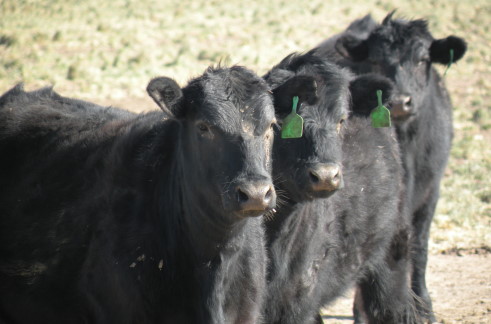
Agricultural News
Heifers Lead Record Angus Price Premiums
Fri, 13 Mar 2015 12:04:50 CDT
 As the light turned green for cowherd expansion across most of the United States last fall, farmers and ranchers turned to Angus heifers. Meanwhile, cattle feeders kept bidding more for their steer brothers.
As the light turned green for cowherd expansion across most of the United States last fall, farmers and ranchers turned to Angus heifers. Meanwhile, cattle feeders kept bidding more for their steer brothers.
Proven performance over the decades in a beef market that increasingly values high quality justified those bids.
That's one way to read results from a 16-year comparative calf-price study by Certified Angus Beef LLC (CAB). The fall 2014 "Here's the Premium" (HTP) report compares auction prices for nearly 14,000 calves of known Angus vs. non-Angus genetics at 10 markets from California to Kentucky and North Dakota to New Mexico.
"Nobody imagined the average value of all calves would nearly double in the two years since the last report, but that's what happened," said Steve Suther, director of industry information for CAB.
"The price of beef has risen dramatically as well," he said. "From the auction bidders to consumers at the retail meat case or restaurant, they know it costs a lot more to buy any calf or any beef. But at these prices, it only costs a little more to go first class."
Angus steers and heifers averaging 524 and 509 pounds (lb.), respectively, brought a combined average of $6.93 per hundredweight (cwt.) over all other calves of similar size and
condition. That's up more than $1.60 per cwt. from 2012, but still only 1% of the overall calf price increase since then.
Lee Schulz, Iowa State University economist who analyzed the data for the 2014 report, said all prices are high because of "very strong demand for a very tight supply, for all of the calves. But when you look at premiums paid for some of the cattle, it's because of added value associated with them over time cattle that work because of their genetics, health and management attributes."
In all the price data on 314,304 cattle in 14,547 lots since early 1999, there has always been a premium for black Angus steers and heifers. This is the first time in 21 reports that both Angus steer and heifer premiums over non-Angus have set records.
While steers always bring more, their edge over heifers of equal quality was razor thin in the 2014 study: The premium for Angus steers over non-Angus was just short of $7 per cwt., but the Angus advantage for heifers was only 12 cents behind. In 2012, the heifer premium lagged by $1.80.
"Last fall's market speaks directly to demand for Angus females over other breed choices," Suther said. "By 2013, the spread between steers and heifers was starting to narrow as producers retained a few more heifers. But last fall, the gap was wider than usual because cattle feeders were making money and wanted steers to fill pens. Angus heifers stood out as the exception going back to the country, sometimes by way of feedlot conditioning and breeding."
The former record for smallest margin between Angus steer and heifer premiums in the CAB price data was in 2004, at a 24-cent spread, and Schulz pointed to the previous cattle-cycle trough of 1994 as the last time the U.S. saw larger year-over-year growth in heifer retention.
"We're at a hot point in the building of the beef cattle herd," he said. "The extraordinary prices paid for calves over the past year have encouraged producers to cull fewer cows and retain more heifers."
USDA numbers show 2014 beef cow slaughter at 17.9% below 2013 and 27.3% below the previous five-year average. At just 8.8% of the 2014 starting inventory, it was the first year of "single-digit beef cow culling" since 2007, Schulz said.
"This is a time when many buyers at feeder cattle auctions have likely been looking at heifer calves as replacements for rebuilding herds, rather than going on to feedlots," he added. Already, the inventory of beef replacement heifers is 19.5% of the herd, the largest share in 19 years of USDA records. The number of beef heifers expected to calve is up 7.3%, just from last year.
Of course, rapid rebuilding only accentuates the shortage of calves for the feedlot in the near term, and the premium is on lowering risk at historically high prices.
In the CAB price data from last fall, calves that were weaned and vaccinated earned a $10.16/cwt. premium over those that were not. That was up from $7.36 in the study two years earlier, a widening spread that Schulz said he has seen in his own research.
Tying that back to the Angus calf prices, Schulz said, "You can look at these characteristics in a similar way, because what has been attracting a premium is still attracting a premium."
The percentage of Angus influence in U.S. beef herds grew from 50% in 1999 to 75% today, but demand more than kept up with the growing supply.
"We might question branding or some other program sustaining a premium over time," Schulz said. "If it's garnering a premium today, will it last or disappear when there are more of those calves available? These numbers show it lasts.
"A lot has to do with producer-buyers understanding what's embodied in those cattle, and that had to start with the end-user, the beef buyer, filtered all the way back to the farm and
ranch," he said. "That has just continued to grow as we've maintained the trend for stronger Angus premiums over non-Angus calves."
WebReadyTM Powered by WireReady® NSI
Top Agricultural News
More Headlines...



















